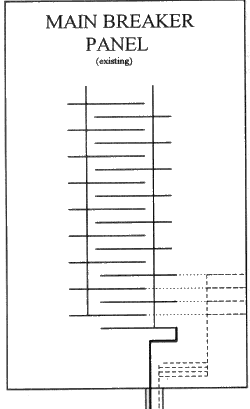

|
The Emergency Standby Power System (ESPS) is designed to provide electricity when normal utility power fails. Lights, office equipment, and home appliances can all be powered with the ESPS. Due to their sensitive nature, computers require the additional protection of an uninterruptible power source. The components for the ESPS are a special combination inverter/charger*, a battery bank, and related safety equipment. Under normal circumstances, utility power is connected to the inverter/charger to charge the batteries and also to power the loads. When the utility power fails, the inverter/charger automatically takes stored power from the batteries, converts it to 120 volts AC, and supplies it to the loads. In this way the loads continue to operate at all times. The size of the inverter/charger and battery bank is determined by the loads to be run and the duration that the loads will be expected to operate in the event of an outage. The total connected load to be powered (expressed in watts) determines the size of the inverter/charger that is required. The amount of time that backup power is expected to be needed determines the capacity of the batteries. The larger the battery set, the longer the loads will operate during an outage. The overall size of an ESPS system is limited only by budgetary constraints. Other components necessary to install the ESPS are the proper size cables to connect the batteries, cables to connect the batteries to the inverter/charger, DC rated circuit breaker for the battery to inverter/charger cables, and a box for the batteries. 120 volt AC wiring is required to connect the inverter/charger into the existing home or office wiring system. * The inverter changes DC (direct current ) into AC (alternating current), the charger changes AC to DC. |
| Utility Power---> | Inverter Charger---> | Loads |
| | * | ||
| Battery | ||
| Utility On | ||
| Utility Power | -| |- | Inverter Charger---> | Loads |
| * | | |||
| Battery | |||
| Utility Off | |||

|
| EMERGENCY STANDBY POWER SYSTEM One Line Wiring Diagram |
| There should be a sign on the front of the main panel & at the main breaker that reads:
WITH A STAND-BY POWER SOURCE TURNING OFF THE MAIN BREAKER WILL NOT TURN OFF ALL CIRCUTS TURN OFF SUB-PANEL MAIN BREAKERS TO DISABLE STAND-BY CIRCUTS |
| .......... existing wiring to be replaced
- - - - new distribution wiring
_____ new main panel to inverter/charger _____ battery to inverter/charger cable |

|
Why is standby power important? Standby power is common in areas where utility (or grid) power is unreliable. It is useful in urban settings to provide basic electricity and power for personal electronics and appliances in the event of blackout or act of Mother Nature. Standby power is usually reserved for hours, maybe days of backup electricity, and found in international applications which are more urban, than rural.
Benefits of a Trace Inverter
in a standby power application
The standby power market is extremely diverse--from small resort hotels and office locales, to private residences. As a rule of thumb, if electrical energy is a necessary requirement of daily operations, an inverter--employed as part of a complete standby system package--can be an integral part of everyday life.
Inverters vs Generators
One of the more common misconceptions is the number of batteries required to power an inverter. Dependent on the size of inverter used, a typical battery bank can vary from two to eight batteries. If energy needs are small, say, powering a resort cabin, two batteries will usually do the job. However, if a sine wave inverter is the backbone for your business, four to eight batteries should be considered. Adequately charging a battery bank should not be a concern, as Trace Engineering's state-of-the-art three-stage battery charger-- when powered by grid--will amply charge your battery bank. Solar, wind, hydro and generators are also common charging appliances. One more note on batteries deals with "type" of battery required: Deep cycle batteries are made with thick plate construction and are designed for repeated, long, continuous, deep discharge cycles encountered in alternative energy or standby power use. Deep cycle batteries are rated in either "minutes reserve capacity" or "amp-hours capacity," (usually over a 20 hour period.) Both sealed and flooded lead acid batteries work equally well. And, whereas sealed batteries are more expensive, they are basically maintenance free. Lead acid batteries, on the other hand, require monthly maintenance, but are lower in cost. Automotive starting batteries are not recommended. Starting batteries are designed strictly to provide the brief, very high current output required to crank engines, and are unsuitable for repeated, long or deep discharge cycles. Starting batteries are rated in "cold cranking amps," with a 30 second maximum output rating.
All ESPS are capable of being solar assisted or even totally solar powered. All ESPS are supplied with complete wiring diagrams and full installation instructions. If you are located in Hawai`i and would like more information about ESPS systems, contact EMS |
